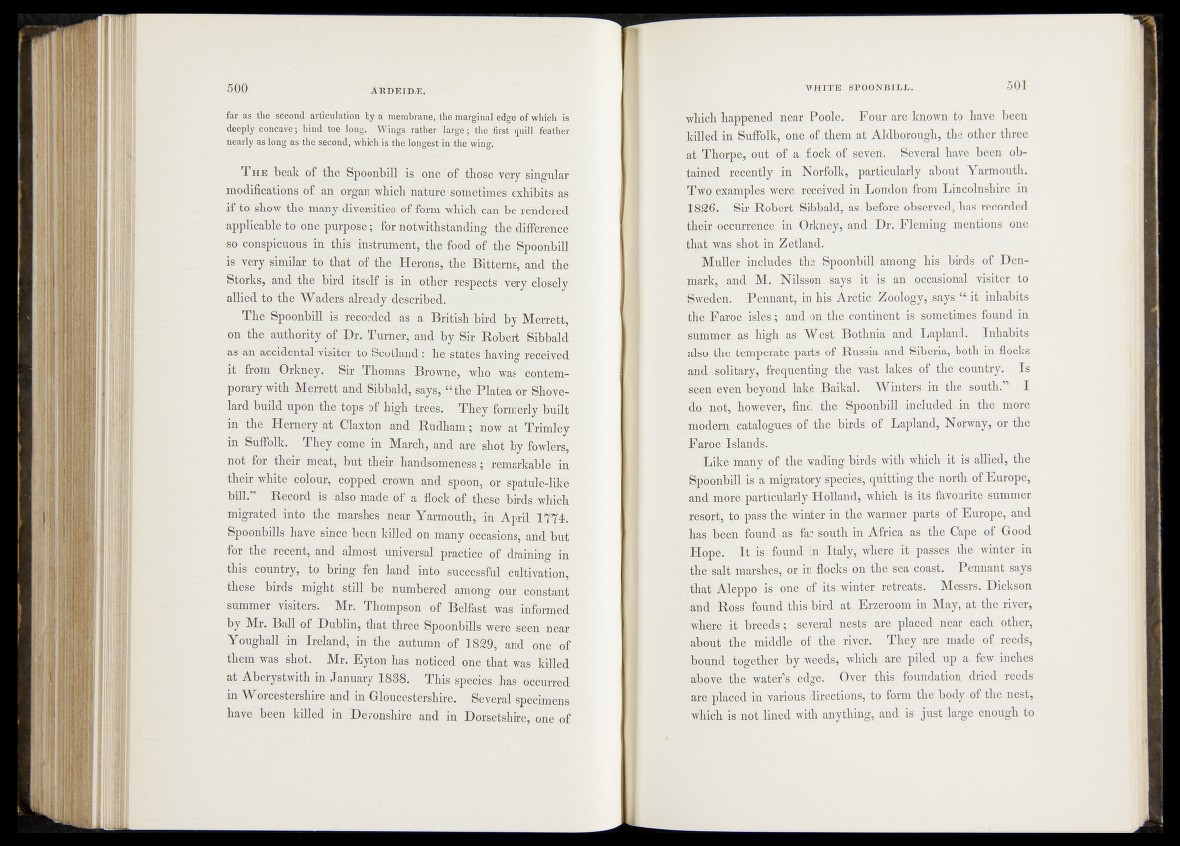
far as the second articulation by a 'membrane, the marginal edge of which is
deeply concave j hind toe long.- "Wings rather large j-the-first'quill'featK^'
nearly as long as,the second, which is the longest in the wing.
T h e beak of the Spoonbill is one of those very singular
modifications of an organ which nature sometimes exhibits as
if to show the many diversities b f form which can Be rendered
applicable to'one purpose; for notwithstanding, the difference
so conspicuous in this'instrument, the'food of the1 Spoonbill
is very similar to that of the Herons, .the’ Bitterns, and the
Storks, and the bird itself is in ; other fespècts very closely
allied to the Waders already described.
The Spoonbill is recorded - as a British’ bird by -Meiéetf,
on the authority of Dr. Turner, and by Sir Robert Sibbaltli
as an accidental visiter to Scotland: he states having received
it from Orkney-.; Sir Thomas' Browne, who was^cehtem-
porarywith Merrett and Sibbald, says, “ the Platea or Shove-
lard build upon thé fops of high tree's."- They fo rm e ^ b u ilt
in the Hernery at -Glaxton and Rudham;now at Trimley
in Suffolk. They come in - Marcly.and- are1 shot|®y fowlers,
not for-their meat; but Xheir^handsomeflesk j-frémarkafric'iii
their white colour, copped., crown, arid; spoon,-, or spatule-lïkê
bill. Record io- also made of a flock of these1 birds which
migrated into the marshesbnear Yarmouth, in 'April 1774.
Spoonbills have since been killed on man^'dfefbion^^fid-but
for the recent, and almost ^universal practice öf draining in
, this country/ to bring fen land into successful ‘jfjfitivation,
.•these birds might still be numbered - among our iéb'risiknt
summer visiters. - Mr. Thompson of Belfast was informed
by Mr. Ball of Dublin, that three Spoonbills were ;<seèn~ near
Youghall in Ireland^ in the autumn-of. 18^9, and one of
them was shot. Mr. Eyton has noticed one that was filled
at Aberystwith in January 1838.- This species has ©cöurred
in Worcestershire and in Gloucestershire. Several specimens
have been killed in Devonshire and in Dorsetshire, one of
which happened-near Poole. Four are known to have been
killed in Suffolk,: ones. of them at Aldborough, the other three
at Thorpe,, out. of a. flock of seven. Several have been obtained.
r e c e n t l yNo r f o l k , particularly, about Yarmouth.
Two examples were received in London from Lincolnshire in
18&6. Sir -.Robert > Sibbald, as. before observed, has recorded
‘their .occurrence in -Orkney, arid Dr. Fleming mentions one
that was shot in Zetland.
'-.-'■Muller includes theriSpoöribilï- among his birds of Denmark;
and M. -Nilsson ^ lfliit'1 1 1 an occasional visiter to
Sweden. Pennant, in his; Arêtier Zoology, says-^ it inhabits
■file. Faroe* isies;;, a n d j^ ^ fl^ n ^ h ïe p t is, sometimes found in
grimmer., as^high-ias Wést Bothnia and Lapland. Inhabits
’also &,e^mperàï^rparts' of Ruslli and Siberia-, both.in flocks
anfl .solitary,' fr eque|j|irig‘t f l e i v a s ^ t h e r i c O u n t r y . • Js
^rifeén even be^ni^ l^feliBaikalvv , Winters- in the,, s o u t h I
^o, not,qhowove%find the* Spoonbilfem^ludeddn the more
jrioderri'cakUl^^^dft thljpifdsriof La$knd, Norway/or tflé
Faroe IslaStd§^|
ifLiiM^Tnanyllî the.wadingihkds^wrtb which it is allied, the
Spoonbill i/-a .migrator-ytspe^l^^uittirig thennorth of Europe,
anff i'pre.particrilarly Holland, which limits favourite summer
"resort, to pass the-winter in the warmer parts of Europe, and
,ha% been ÿ ^ d as fàtvsouth in Africa as the- Ggpe^of Good
Hope. T. fmn a d y n Htalykwhere,it- passes!,the winter in
ithe salt- marshesj or in fló^s/Ön'thë sea-coast. Pennant says
that ÿéLhppqriik*O^S^itS'wint'er. f r e t r e a t sMéssrs. Dickson
i|h d Ross found tM%bird at ..Erzeropm-in May, at the river,
where several nests are placed near each other,
about,the middle|0f thë r^ e ^ ./T h e y ,a re made of reeds,
bound together b ||® ^ d s£ which, are -piled up a few-inches
above the waters edge,. Oyer, this foundation dried reeds
are placed in various dirçctioris, to form the body of the nest,
which is not lined with anything, and is just large enough to